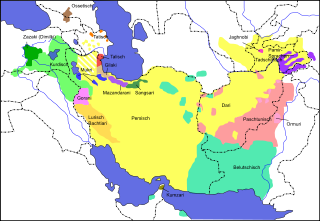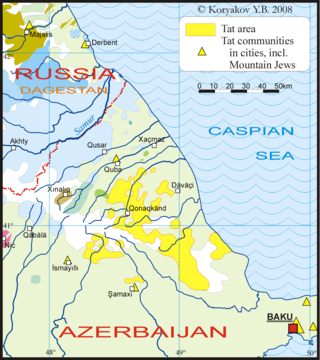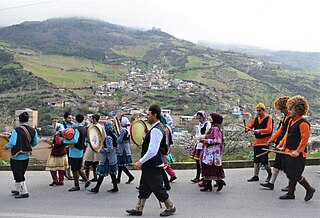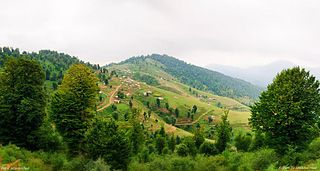
Gilan Province is one of the 31 provinces of Iran, in the northwest of the country. It lies along the Caspian Sea, in Iran's Region 3, west of the province of Mazandaran, east of the province of Ardabil, and north of the provinces of Zanjan and Qazvin. It borders Azerbaijan in the north.

Ardabil Province is one of the 31 provinces of Iran. It is in the northwest of the country, in Region 3, bordering the Republic of Azerbaijan, and the Iranian provinces of East Azerbaijan, Zanjan, and Gilan. Its administrative centre is the city of Ardabil. The province, spanning an area of 18,011 km2, and established in 1993, was carved out of the eastern part of East Azerbaijan province.

Zaza or Zazaki is a Northwestern Iranian language spoken primarily in eastern Turkey by the Zazas. The language is a part of the Zaza–Gorani language group of the northwestern group of the Iranian branch. The glossonym Zaza originated as a pejorative and many Zazas call their language Dimlî.
Gilaks are an Iranian ethnic group native to the south of Caspian sea. They form one of the main ethnic groups residing in the northern parts of Iran. Gilak people, along with the closely related Mazandarani people, comprise part of the Caspian people, who inhabit the southern and southwestern coastal regions of the Caspian Sea.

Tat, also known as Caucasian Persian, Tat/Tati Persian, or Caucasian Tat, is a Southwestern Iranian language closely related to, but not fully mutually intelligible with Persian and spoken by the Tats in Azerbaijan and Russia. There is also an Iranian language called Judeo-Tat spoken by Mountain Jews.
The Parthian language, also known as Arsacid Pahlavi and Pahlawānīg, is an extinct ancient Northwestern Iranian language once spoken in Parthia, a region situated in present-day northeastern Iran and Turkmenistan. Parthian was the language of state of the Arsacid Parthian Empire, as well as of its eponymous branches of the Arsacid dynasty of Armenia, Arsacid dynasty of Iberia, and the Arsacid dynasty of Caucasian Albania.

Mazandarani is an Iranian language of the Northwestern branch spoken by the Mazandarani people. As of 2021, there were 1.36 million native speakers. The language appears to be decreasing, as it is threatened, and due to the majority of its speakers shifting to Iranian Persian. As a member of the Northwestern branch, etymologically speaking, it is rather closely related to Gilaki and also related to Persian, which belongs to the Southwestern branch. Though the Persian language has influenced Mazandarani to a great extent, Mazandarani still survives as an independent language with a northwestern Iranian origin.

Gilaki is an Iranian language of the Northwestern branch, spoken in south of Caspian Sea by Gilak people. Gilaki is closely related to Mazandarani. The two languages of Gilaki and Mazandarani have similar vocabularies. The Gilaki and Mazandarani languages share certain typological features with Caucasian languages, reflecting the history, ethnic identity, and close relatedness to the Caucasus region and Caucasian peoples of the Gilak people and Mazandarani people.

Talysh is a Northwestern Iranian language spoken in the northern regions of the Iranian provinces of Gilan and Ardabil and the southern regions of the Republic of Azerbaijan by around 500,000-800,000 people. Talysh language is closely related to the Tati language. It includes many dialects usually divided into three main clusters: Northern, Central (Iran) and Southern (Iran). Talysh is partially, but not fully, intelligible with Persian. Talysh is classified as "vulnerable" by UNESCO's Atlas of the World's Languages in Danger.

The Mazanderani people, also known as the Tabari people or Tapuri people, are an Iranian people who are indigenous to the Caspian sea region of Iran. They are also referred to as Mazanis for short. They inhabit the southern coast of the Caspian Sea and are part of the historical region known as Tabaristan. The Alborz mountains mark the southern boundary of the area settled by the Mazanderani people.

Takestan County is in Qazvin province, Iran. Its capital is the city of Takestan. Most people of Takestan County are Tat and they speak Tati.

Talesh County (Persian: شهرستان تالش; also known as Tavalesh is in Gilan province, in northwestern Iran. Its capital is the city of Tālesh.

The Tati language is a Northwestern Iranian language spoken by the Tat people of Iran which is closely related to other languages such as Talysh, Zaza, Mazandarani and Gilaki.
Harzandi or Harzani is a dialect of the Tati language, spoken in the northern regions of the East Azarbaijan province of Iran. It is strictly an oral language, and a descendant of the Old Azeri language that has long been extinct as a result of the diffusion of Turkish in the area. Harzandi has many common linguistic features with both Talysh and Zaza and was positioned between the Talysh and Zaza.
Moallem Kalayeh, also Romanized as Mo’allem Kalāyeh, is a city in, and the capital of, Alamut-e Sharqi District of Qazvin County, Qazvin province, Iran. It also serves as the administrative center for Moallem Kalayeh Rural District. People of the city are Tat and they speak Tati language.

Razmian, also Romanized as Rāzmīān, is a city in, and the capital of, Alamut-e Gharbi District of Qazvin County, Qazvin province, Iran. People of Razmian are Tat and they speak Tati language.
The Tat people of Iran are an Iranian people living in northern Iran, especially in Qazvin province.
Vafs is a village in Esfandan Rural District, in the Central District of Komijan County, Markazi Province, Iran. At the 2006 census, its population was 1,607, in 509 families. The inhabitants belong to the Tat ethnic group and they speak Tati language.
Khoein is a village in Ijrud-e Pain Rural District, Halab District, Ijrud County, Zanjan Province, Iran. At the 2006 census, its population was 132, in 57 families. People of Khoein speak Tati language. Tati is old language of Aazerbaijan.
Tatoid dilalects are dialects of the Tati language spoken in the Iranian provinces of Gilan, Qazvin and Alborz. Tatoid two Tati like ofshoots: Rudbari, Taleghani and Alamuti. Tatoid includes the Rudbari, Taleghani and Alamuti dialects. According to Stilo, this special status for this recent type is that these two varieties were originally Tatic which, under the intense influences of Caspian and Persian, have lost all their Tatic grammatical structures.













